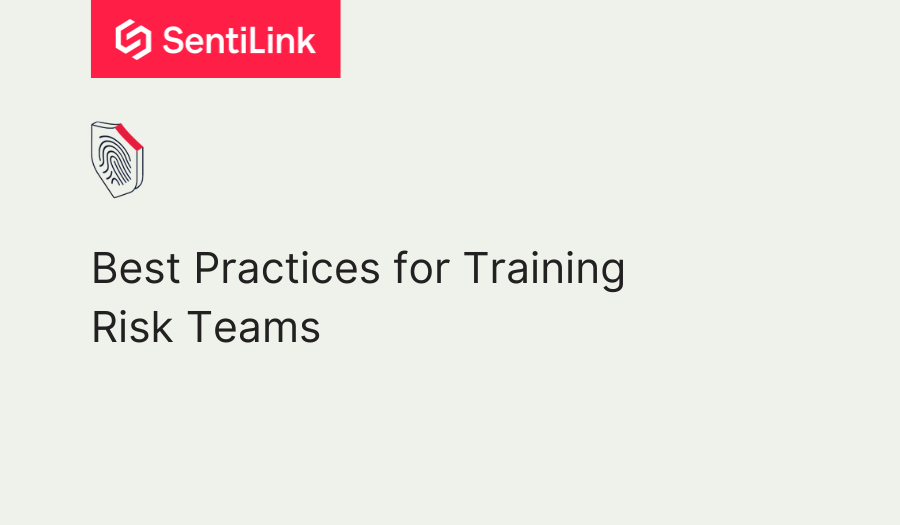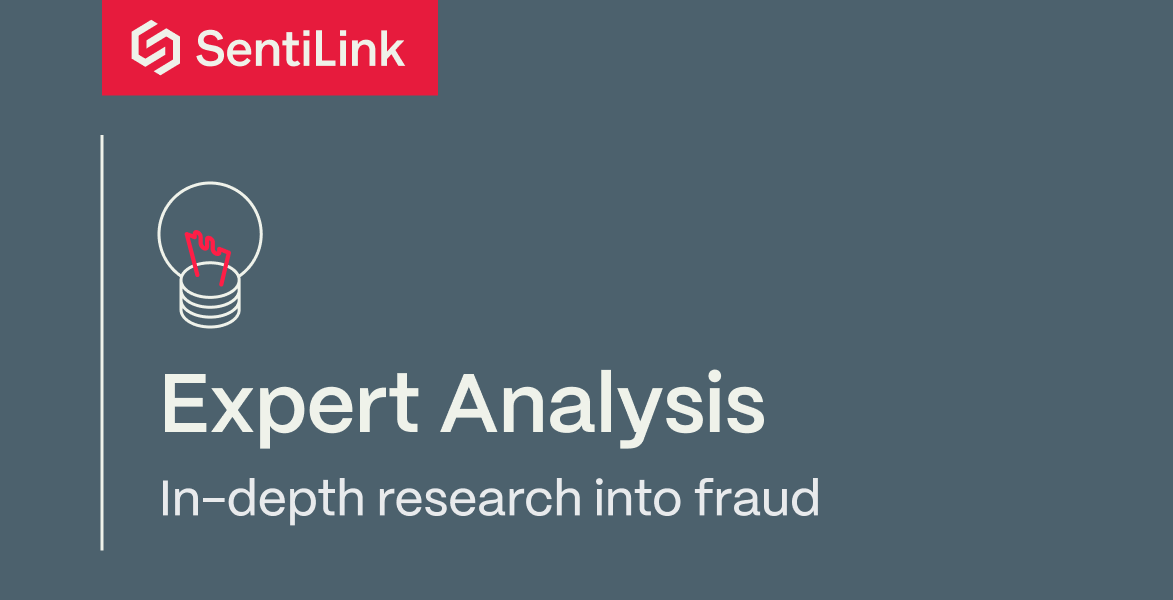Blog post
Best Practices for Training Risk Teams
SentiLink
Published
May 3, 2023

At SentiLink we are uniquely successful because we have a uniquely rigorous approach to cultivating the deep understanding of our Fraud Intelligence Team. Not only is this a core value of SentiLink, but it is an essential element of a high caliber Risk function within any organization.
In this post, we will offer best practices for assessing and up-leveling your onboarding practices for new Risk analysts.
Before we dive into the details of setting up new analysts for success, let’s first look at SentiLink’s perspective on deep understanding.
Deep Understanding at SentiLink
Company wide, we focus on knowing the true characteristics of fraud – as experts in detecting and deterring identity fraud, we ascribe to the following behaviors in exhibiting deep understanding:
- Knowing all the details.
- Sharing your thoughts.
- Asking the right questions to address issues.
- Recognizing anomalies and investigating.
- Being curious and asking, “does this make sense?”
All SentiLink employees are well equipped to apply these behaviors from day one by way of mandatory training in the account opening fraud landscape and the tools we use to support our partners. Our commitment to deep understanding enables our team to create and sell best-in-class solutions.
As you scale your Risk function, here are several guidelines we have learned along the way that we recommend to ensure your new analysts bolster your team’s effectiveness.
Setting up New Analysts for Success
Day One: Along with the typical company-wide onboarding, set up your new analyst with a checklist of expectations for their role in Risk. This checklist should clearly define the research, testing, and learning activities the analyst can expect to engage within the first four to six weeks of joining the team. We recommend the Risk team lead meet with a new analyst daily for the first two weeks to answer questions and ensure the path to success is clear (or if you haven’t reached enough scale for a manager, a senior member of the team can do this).
New Risk team members should also receive an overview of all responsibilities of the Risk function from a senior analyst – who can also serve as a mentor and resource for the new analyst going forward. As an example, our analysts focus on reviewing applications for several queues, so we familiarize each new analyst on these three categories of manual review work:
- Operations: A random sample of applications from existing partners used to ensure the Scores models remain performant. We also assess and mitigate fraud attacks as well as address cases that are escalated to us by our partners.
- Retro Studies: Applications from potential partners used to assess performance and calibrate Scores models based on the data received. We also share specific cases for review with potential partners that highlight nuances of fraud in their application flow.
- R&D: Collaboration with our Data Science team for extracting new features and improving our models.
While the roles and responsibilities for your Risk team are specific to your business needs, the main takeaway is that each incoming analyst should be briefed on the functional responsibilities of the Risk team.
Ramping New Analysts Quickly
Month One: If your goal is to ramp up your new Risk team members quickly, you will need rigorous, well-supported training. The first month of training is crucial for instilling the level of consistency required to sustain a high-performance Risk team. New analysts should be introduced to the Risk team toolset on their first day, after which we recommend a two to four week training course that builds and tests core skills and understanding needed to perform the role of a risk analyst.
As an example, all new SentiLink employees see the SentiLink Dashboard in their first session of a two week course we refer to as our Fraud Intelligence Training Program. Our Risk team completes the intensive version of this training along with new members of the Data Science, Sales and Partner Success teams (all other new employees take the lite version of the course over the same two week period). The initial sessions of the course consist of live training with experienced Fraud Intelligence Analysts and sequestered blocks of focused self-study. Due to the detail-oriented nature of the role, new analysts continue collaborating with senior analysts to label cases during the latter two weeks of the first month to ensure they follow the high fidelity labeling conventions of the Fraud Intelligence Team.
New analysts who join the SentiLink team can count on their colleagues for help with nuanced cases during their first month and beyond, until they are able to review and apply labels autonomously. However, ensuring the stickiness of the training during this intensive time is not guaranteed, so we recommend building structured resources and ensuring accessible support into the training program so that the first month is as empowering as possible.
Structured Resources are Crucial
Equip new analysts with a wealth of resources that are stored in an easy to find (or bookmark) and easy to navigate repository. Here are potential resources to include:
- Syllabus that outlines the training program.
- Documented guidance for case labeling logic.
- Case workbook that includes a comprehensive sampling of practice cases for the vectors of fraud that are typical for your business (example: our intensive course workbook contains 150 cases – 50 cases requiring various types of synthetic ID labels, 50 cases requiring various ID theft labels, and 50 test cases containing a mix of applications requiring labels from either categories of ID fraud).
- Toolset list with all tools used for investigations with associated user guides for the tools that are core to the Risk team’s work.
- Taxonomy with detailed scenario-based definitions of fraud and non-fraud labels (example: Our taxonomy includes over 30 labels complete with previously labeled sample cases so new analysts have a sense of how labels were applied historically).
Accessible Support is Crucial
In addition to the central repository of resources, new analysts will also need continuous access to the wisdom and experience of the team. Here are practical ways to build support into the ramp process:
- Schedule live training sessions segmented by the fraud categories that are common for your business. For example, our new Fraud Intelligence Team members participate in 60 minute live sessions with a senior member where the new analyst watches the senior analyst work cases for the first portion of the time. The new analyst is then welcomed to “drive” the remaining minutes of the session where they can ask questions as they work to ensure their logic is on the right track.
- Create a communication path (i.e. Slack channel, Teams group, etc.) that is monitored by senior members of the Risk team where trainees asynchronously ask questions about the cases they are working on during their training program.
- Host weekly office hours where trainees can ask questions live about the cases they are working.
- Offer ride-along sessions where new analysts can learn from the experiences of, as well as trade notes with, senior analysts (both present experience and experiences from roles prior to joining the team).
- Build collaborative review sessions into the weekly schedule of the Risk team where team members can use focused time to work cases in small groups and discuss the labels selected as an entire Risk team. This ensures labeling accuracy and consistency remains high team-wide and gives analysts a chance to address nuanced fraud vectors as a team. As an example, SentiLink built a weekly company-wide case review event where all employees are randomly paired and collaboratively label 5 to 7 cases. This event is hosted by the Fraud Intelligence Team which changes the theme of the cases each week to keep the review process interesting. At the end of the paired time, we come together as a company and a Fraud Intelligence Analyst reviews the labels and answers any questions from the SentiLink team.
Maintaining a High Bar
Take great care to measure all of your risk analysts using the same high standards for labeling accuracy while also building a diverse group with different industry backgrounds – recognizing the valuable, unique knowledge each Risk team member has to share. Fostering deep understanding within your Risk team requires encouraging new analysts to ask several questions and equipping senior members to answer those questions. An established quality assurance process ensures cases labeled by new risk analysts are reviewed by their manager and feedback is given immediately, further setting them up for success in the role. The QA should not stop once a new analyst is fully ramped, but rather all analysts should engage in regular QA sampling such that high standards for labeling accuracy are perpetuated.
Our Fraud Intelligence Team has over 80 years of combined fraud experience in multiple industries. From this expansive knowledge trust, we teach all the details surrounding fraud: synthetic fraud, identity theft, first-party fraud, friendly fraud, elder abuse, etc. We make certain that after completing the Fraud Intelligence Training Program, everyone (Fraud Intelligence Analysts and the other SentiLink teams) are able to review and label applications without help. The guidance given here will ensure your team is also well prepared for success.
Related Content

Blog article
April 3, 2024
Tips from a Fraud Fighter for Spotting Assumed Identity Abuse
Read article
Blog article
February 29, 2024
Reducing Complexity in Model Risk Management with Attributes
Read article
Blog article
January 18, 2024